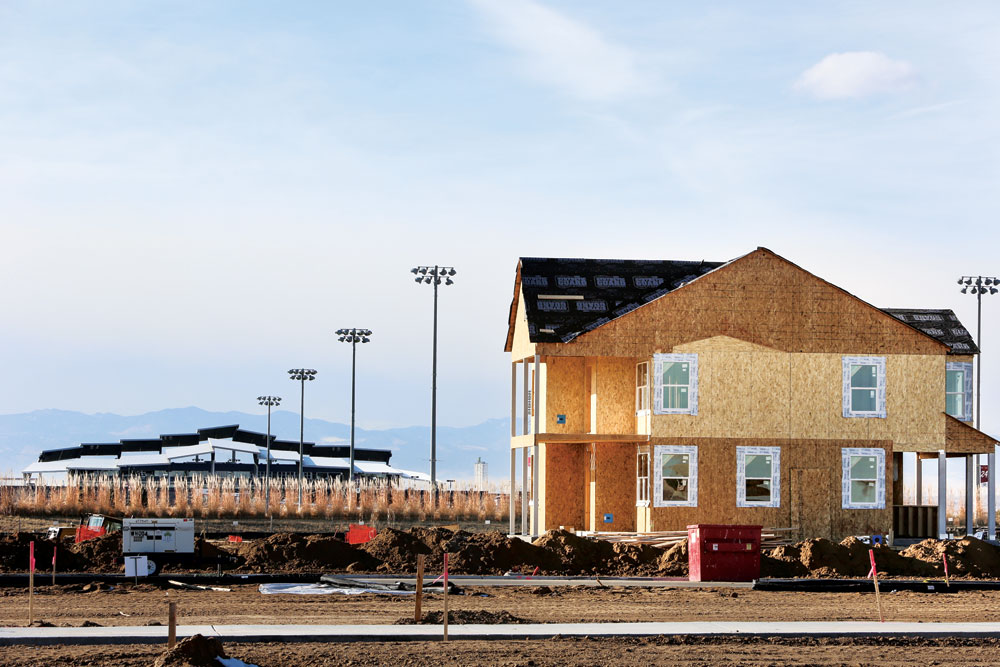
Beeler Park is the first neighborhood in the 620-acre parcel of Stapleton land north of 56th Ave. A total of 2,000 single-family homes and 400 apartments will be built on this land that adjoins the Rocky Mountain Arsenal National Wildlife Refuge.
The Rocky Mountain Arsenal National Wildlife Refuge (RMANWR) really is where the buffalo (bison) roam. And Beeler Park really is where urban meets the Great Plains. Both assets are moving ahead rapidly in fulfilling longstanding visions for land that not so long ago was on the outer fringes of the Denver metro area.
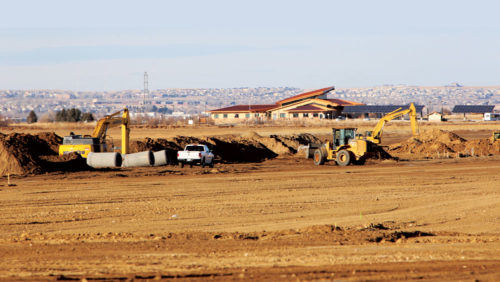
The newest part of Stapleton abuts the Rocky Mountain Arsenal National Wildlife Refuge and its slope-roofed visitor center.
Beeler Park is the first phase of development on Section 10, the last large land parcel in Stapleton to undergo conversion from abandoned airport to “out-fill” urban development. Section 10 is a one-square-mile area bordered by 56th Ave. on the south, Dick’s Sporting Goods Park on the west, and RMANWR on the north. At full build-out, it is projected to have 2,400 single-family homes and 400 apartments.

Rocky Mountain Arsenal National Wildlife Refuge (16,000 acres). Stapleton Section 10 Master Plan The Section 10 master plan features a “grand arc” of trunk open space sweeping north from 56th Ave. and terminating in a 68-acre retention pond in the northwest corner of the site. Two linear parks radiate northeast from the grand arc and link to a 75- foot wide buffer on the north and east sides of the section, creating a transition from housing to wildlife refuge. A regional trail in the grand arc connects to the refuge at the northwest corner of Section 10. Pedestrian/bike paths will be built in the buffer areas. The Wildlife Refuge is directly to the north and east. Commerce City is directly to the west.
Approximately 30 single-family homes are under construction and the first residents are expected to move in during January. Beeler Park occupies 130 acres of the 620-acre Section 10. At build-out it is expected to accommodate 1,200 dwelling units and upwards of 70,000 square feet of mixed-use commercial development fronting 56th Ave. and the extension of Central Park Blvd. north of 56th.
In Beeler Park, the western third of Section 10, 10 builders have already purchased lots. Many of the roads and alleys have been constructed and Central Park Blvd. has been extended to connect to Prairie Parkway in Commerce City. That roadway is expected to be open to the public in February once Xcel installs streetlights.
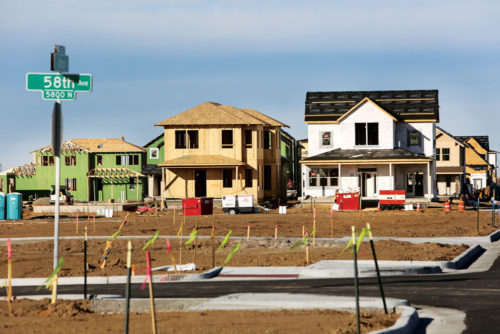
Homes are under construction. Ten Stapleton builders have purchased lots in Beeler Park.
Next Door Neighbor: The Wildlife Refuge
“It’s a big change for us. There are going to be great positives that come from it, lots of new neighbors, lots of new people who will be interested in the Arsenal.” That’s David Lucas, manager of the RMANWR. Urban development is now cheek to jowl with the 16,000-acre refuge that is literally “well positioned to leverage … early investments to create world-class wildlife habitat and a conservation education facility in the heart of a rapidly growing urban metropolis.” That phrase is taken from the recently completed environmental impact statement that recommended Rocky Mountain Arsenal become a new type of facility among the U.S. Fish & Wildlife’s holdings—an “urban refuge,” one that seeks to “welcome many more nontraditional visitors, and increase refuge access from outlying communities.”
In Lucas’ words, it is a shift “from stay-away towards a place of learning and endless outdoor opportunities.”
Two immediate results of that culture change are the refuge’s participation in the Great Outdoors Colorado Inspire grant (see article page 12) and a decision to add seven new trailheads at the property boundary. Two of those trailheads will be on 56th Ave. near Uvalda and Chambers streets. Funded in part by a grant through the Colorado Federal Lands Access Program (FLAP), the new trailheads will permit bicycle access to and through the refuge for the first time. The program also includes a 7.5-mile extension of the Rocky Mountain Greenway that will eventually link to Rocky Flats National Wildlife Refuge all the way to Rocky Mountain National Park. Design of the $1.6 million in improvements will begin in the fall of 2017 with construction the following year.
This close relationship between urban development and a natural area was envisioned in the early planning for an abandoned Stapleton International Airport dating to the late 1980s. The Rocky Mountain Arsenal National Wildlife Refuge Act was approved by Congress in 1992. (The refuge was officially established in 2004). And in 1995, the Denver City Council adopted the Stapleton Development Plan, aka Green Book, which foresaw a redeveloped Stapleton transitioning from an extension of the city grid on the south to fingers of urban development extending into a re-created High Plains landform on the north.
Parks and Other Amenities
Massive amounts of dirt have been moved to create open space that doubles as storm drainage. It is a twist on the usual sequence: earth-moving to restore a rolling, High Plains landscape from its previous incarnation as a man-made flat plain for the takeoff and landing of jet aircraft. Prospective purchasers need to understand that most of the open space in Section 10 will not be traditional green grass city parks but, instead, a landscape of dry-land grasses and shrubs, not unlike the refuge itself.
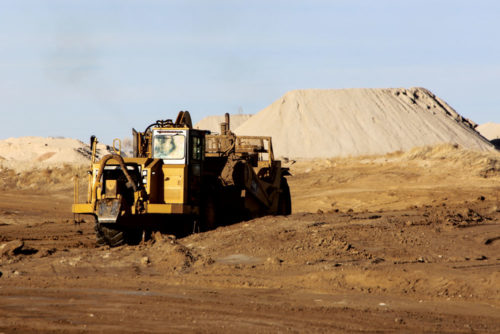
Asphalt and concrete piles recycled from Stapleton are rapidly shrinking as materials are trucked off-site.
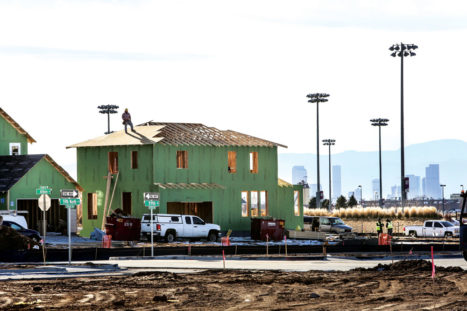
Section 10 sits relatively high, giving views of downtown.
Forest City has proceeded with development at Beeler Park despite the lack of a financing plan for completion of the trunk open space. Storm drainage improvements have been installed, and the land has been graded and will be seeded this winter with a mix of native grasses and shrubs.
However, a plan to pay for “amenities” in the open space is still being developed in a five-way negotiation involving Forest City, Denver, the Denver Urban Renewal Authority, the Park Creek Metropolitan District and Denver Public Schools. Those amenities include multiuse fields, playground equipment, a rest room, hardscape, concrete and crusher fines paths, regional trail connection, trashcans, benches, and shade structures.
Bar Chadwick, of Denver’s Department of Finance and who serves as the mayor’s Stapleton liaison, says the “five partners have been working on details and great strides have been made toward the financing of Section 10. We hope to be able to make an announcement during the first quarter of 2017.”
Removal of Old Runways
Little remains of Stapleton in Section 10. Piles of asphalt and concrete derived from the airport’s runways and taxiways are rapidly being trucked away as the long-sought recycling goal nears completion. Lucas finds the progress on rubble pile removal “miraculous,” adding, “Greg Holt (of Denver Aviation) said it would be gone by December of 2016 and it might well be. That’s great news for all of us who have been looking at it for a decade.”
Moving Forward
Two claims on Section 10 from the days when the refuge was an arsenal have been resolved: construction by Forest City of a new water main for the refuge, replacing one that ran diagonally through the property; and Forest City acquisition from Denver of a railroad easement that served the weapons plant.
The balance of Section 10 will be acquired by Forest City once the developer is ready to begin housing construction east of the trunk open space. Forest City spokesman Tom Gleason said he anticipates that will happen in 2018.



0 Comments